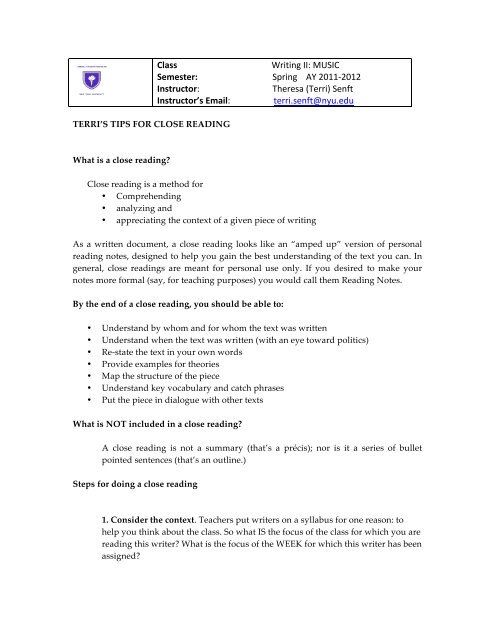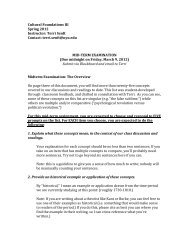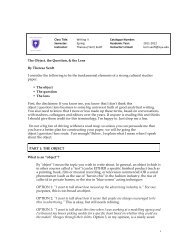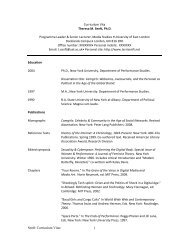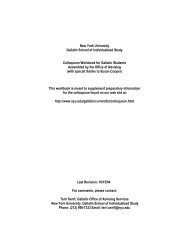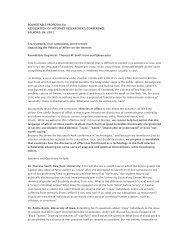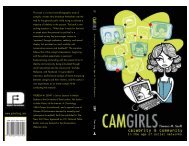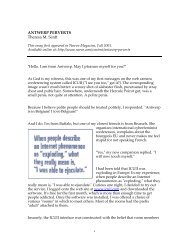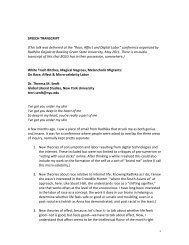TERRI'S TIPS FOR CLOSE READING - Terri Senft
TERRI'S TIPS FOR CLOSE READING - Terri Senft
TERRI'S TIPS FOR CLOSE READING - Terri Senft
You also want an ePaper? Increase the reach of your titles
YUMPU automatically turns print PDFs into web optimized ePapers that Google loves.
TERRI’S <strong>TIPS</strong> <strong>FOR</strong> <strong>CLOSE</strong> <strong>READING</strong><br />
What is a close reading?<br />
Class Writing II: MUSIC<br />
Semester: Spring AY 2011-‐2012<br />
Instructor: Theresa (<strong>Terri</strong>) <strong>Senft</strong><br />
Instructor’s Email: terri.senft@nyu.edu<br />
Close reading is a method for<br />
• Comprehending<br />
• analyzing and<br />
• appreciating the context of a given piece of writing<br />
As a written document, a close reading looks like an “amped up” version of personal<br />
reading notes, designed to help you gain the best understanding of the text you can. In<br />
general, close readings are meant for personal use only. If you desired to make your<br />
notes more formal (say, for teaching purposes) you would call them Reading Notes.<br />
By the end of a close reading, you should be able to:<br />
• Understand by whom and for whom the text was written<br />
• Understand when the text was written (with an eye toward politics)<br />
• Re-‐‑state the text in your own words<br />
• Provide examples for theories<br />
• Map the structure of the piece<br />
• Understand key vocabulary and catch phrases<br />
• Put the piece in dialogue with other texts<br />
What is NOT included in a close reading?<br />
A close reading is not a summary (that’s a précis); nor is it a series of bullet<br />
pointed sentences (that’s an outline.)<br />
Steps for doing a close reading<br />
1. Consider the context. Teachers put writers on a syllabus for one reason: to<br />
help you think about the class. So what IS the focus of the class for which you are<br />
reading this writer? What is the focus of the WEEK for which this writer has been<br />
assigned?
2. Read the text out loud. No, really. Try for two or three sentences at a time at<br />
first, and work up to whole paragraphs later. Listen for words you don'ʹt know<br />
how to pronounce, because there'ʹs a strong chance you don'ʹt know what they<br />
mean, either. Circle them to look up in a minute. As you read aloud, think to<br />
yourself, "ʺAre these the words I would use to make this point to a friend?"ʺ If the<br />
answer is "ʺno"ʺ (and it generally is), then<br />
3. Re-‐‑phrase what you just read in your own words. Ideally, type these words<br />
into your word processor for later use as your reading notes. Remember those<br />
words you couldn'ʹt say? Look them up (I generally use dictionary.com because<br />
I'ʹm almost always online.) Translate EVERY sentence in the piece into your own<br />
language for at least the first few pages.<br />
4. Provide examples for everything. As a critical reader, the two strongest words<br />
you have at your disposal are: <strong>FOR</strong> INSTANCE. If you can provide an example<br />
for every major point the essay is trying to make, you will have understood the<br />
essay. A bonus is that many times, examples COMPLICATE an author'ʹs<br />
argument, which will give you great material to bring in class or in a paper.<br />
5. Recognize and defend yourself against front-‐‑loaded essays. It is common for<br />
editors of journals to demand that writers "ʺfront load"ʺ their essays, compacting<br />
all the findings and deep thoughts into three or four beginning paragraphs that<br />
get unpacked later in the body of the essay. This is done for the speed of<br />
advanced researchers, not the ease of beginning students. If you find yourself<br />
saying WHAAAAT? over and over again, don'ʹt panic. You are probably reading<br />
a front-‐‑loaded essay. Instead, gloss (for now) the dense paragraphs and go right<br />
to the first heading in the essay. That'ʹs the beginning of explanation. Read that<br />
through to the end and then the beginning may make much more sense.<br />
6. Think about structure. Theorists make their living with language, and to<br />
understand theory, you need to understand that it is as carefully crafted as<br />
literature. To this end, note how the piece is structured, and organize your own<br />
notes that way. The easiest way to do this is to write down all the headings and<br />
sub-‐‑headings in an essay, leaving lots of space in between. Then, as you organize<br />
your notes, you will be following the author’s structural logic.<br />
7. Think about language, and make a list of KEY WORDS. Are there any new<br />
words or phrases the writer comes up with? These matter, because they signal<br />
new thoughts that couldn'ʹt be put in old words. Are there any phrases or words<br />
that come up over and over? This repetition is a way of trying to hammer home a<br />
point. Compile definitions for KEY WORDS used by the author, which is a fancy<br />
way of saying vocabularly list. What about the examples the writer uses? How<br />
do they differ from the ones you came up with? Make a note of that, too, and
you'ʹll be working on a potential paper topic while you read, killing two birds<br />
with one stone.<br />
8.Think about argument, and make a list of BULLET POINTS. It'ʹs sometimes<br />
hard to find it, but even the most "ʺcreative"ʺ theorist is expected to make an<br />
argument. To tease the elements of that argument out difficult prose, ask<br />
yourself, "ʺIf I had to summarize this entire essay in five bullet points, what<br />
would they be?"ʺ Somewhere in those bullet points reside both the main and the<br />
secondary arguments of the piece. I will write more about this later because it is<br />
actually one of the hardest part of reading theory, I think.<br />
9. Think about tone. Think about the voice of the writer in this piece. Is it funny,<br />
sad, austere? Does the author talk about him/herself, or is the whole thing<br />
delivered in the third person? If you had to cast this writer as a character in a<br />
movie, how would you dress him/her? Where would s/he live, who would be in<br />
his/her audience?<br />
That'ʹs all the advice I have for close reading. The next advice isn'ʹt technically<br />
about close reading, but can be INVALUABLE for people reading theory. You<br />
need to know that it is possible for you to read someone'ʹs work, put it into your<br />
own words, analyze the language for rhetorical effect, and STILL not quite get<br />
what the writer is saying, simply because you lack the background and historical<br />
knowledge necessary to "ʺget"ʺ the essay in question. Like everyone else, theorists<br />
have their own soap operas, and sometimes you need to know who is delivering<br />
an insult to whom or nothing makes sense. Besides, all gossip is fun, even gossip<br />
about people who have been dead a zillion years, which is why I recommend:<br />
10. Do some cursory research on the author. Go to Google or Wikipedia and<br />
take a general look around. In about fifteen minutes, you should be able to<br />
answer these questions: Who is this person you are reading, and what was life<br />
like in the time they wrote the text in front of you? What is their discipline<br />
(anthropology, sociology, etc. etc.)? Who were they mad at in the academic<br />
world? Who was mad at them? Did they have any love affairs or duels or suicide<br />
attempts worth noting? Also: Were they affiliated with a trend or a school of<br />
thought? Can you summarize that school of thought in a few sentences? If not,<br />
look up the school of thought and read a bit about that.<br />
11. If you are assigned multiple pieces in a week, put the piece you are reading<br />
in some sort of dialogue with other pieces assigned for the week. Because a<br />
juicy subject always has multiple viewpoints, your professor has probably<br />
assigned more than one writer for the week. How does the piece you are reading
"ʺfit"ʺ with the other pieces assigned for the week? Why do you think the professor<br />
put them together the way she did? Again, Google can sometimes help with this.<br />
Try typing two or three of the authors assigned for a week into Google and see<br />
what comes up.<br />
AND FINALLY<br />
12. Stop consuming, start thinking. A good theory class should function<br />
through a dialectic, with students turning ideas over and over again, rather than<br />
absorbing The Truth from on high. This is why teachers think less highly of<br />
students who give "ʺloved it"ʺ or "ʺhated it"ʺ responses to readings than they do<br />
those who take a generative stance, asking "ʺWhat can we learn from this<br />
reading?"ʺ even if that learning is not at all pleasant, agreeable or even morally<br />
defensible in your view. One way to ask "ʺwhat can we learn"ʺ is to hold the theory<br />
up to your mirror of the world to see what reflections and refractions emerge.<br />
From there, you may feel the need to either reconsider what you call reality, or<br />
alter the theory at hand, or a bit of both. Either way, you are thinking rather than<br />
buying, and that'ʹs what makes school different from the mall, even when the<br />
topic is cultural studies.


